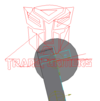|
.: Luke Cole - Home Page :.
(This site hasn't had many changes since 2013) (older version: lc.homedns.org 2003-2005) (long-standing biz: eteckonline.com 2001-2004, coletek.homedns.org 2005-2006, evolved to coletek.org 2007+) (other early online webapps here) |


|
Australian National University (ANU)Drawing using the Scorbot Manipulator ArmA robotic arm is vital for most tasks, such as grabbing a beer from the fridge. Drawing on a piece of paper with any basic manipulator arm is not an easy task. Humans have many sensors, such as vision and touch that allow a human to draw with ease, even as a young child. However most manipulator arms only have motors to move the links, and encoders to read how much the each link has truly moved. The resolution of the encoders clearly effect the resolution for the movement of the end effector, in this case a pen drawing on a piece of paper. Even with high resolution encoders, a manipulator arm with gears and/or belts experience backlash and wear, which require maintenance for optimal performance. Furthermore, humans generally draw/write via supporting the weight of their hand on the drawing surface, which clearly has its advantages. Even though a manipulator arm of this nature is basically "disabled", in terms of a human drawing ability, we can still expect reasonable accurate illustrations and readable text as shown by the two Autobot illustrations on the right. These images where produced in real world, in real time using a real (manipulator arm) robot known as Scorbot-ER VII, developed by Intelitek (formally Eshed Robotec). [ report: Drawing using the Scorbot-ER VII Manipulator Arm ] Stingray - LEGO© robot wall climberStingray is a LEGO© robot built using primarily standard LEGO© components and a LEGO© 1.0 Mindstorm kit. Stingray was designed to climb randomly positioned holes on a steep inclined ramp. The robot was designed, built, modeled and programmed with trivial climbing strategy within two weeks of 2007. The robot computer (RCX 1.0) only has three inputs and three outputs. Two outputs are used to control the three motors (two motors to extend the arm). One input was used for one IR sensor to detect the holes and two touch sensors to detect when the arm has reached its extensions. Another input was used for the encoder on the tail motor which controls the cable mechanism that pans the arm. The final input was used for an encoder to measure the robots angle relative to gravity. Please note the software is still underdevelopment so its full intelligence potention is still unknown, however the video to the right shows its graceful hole climbing ability. [ report: Autonomous LEGO© Climber Project - Stingray ]
|
|||||||||||||||||||||||||||||||||||||||||||||||||||||||
|
© 2000-2024 Luke Cole All rights reserved |








